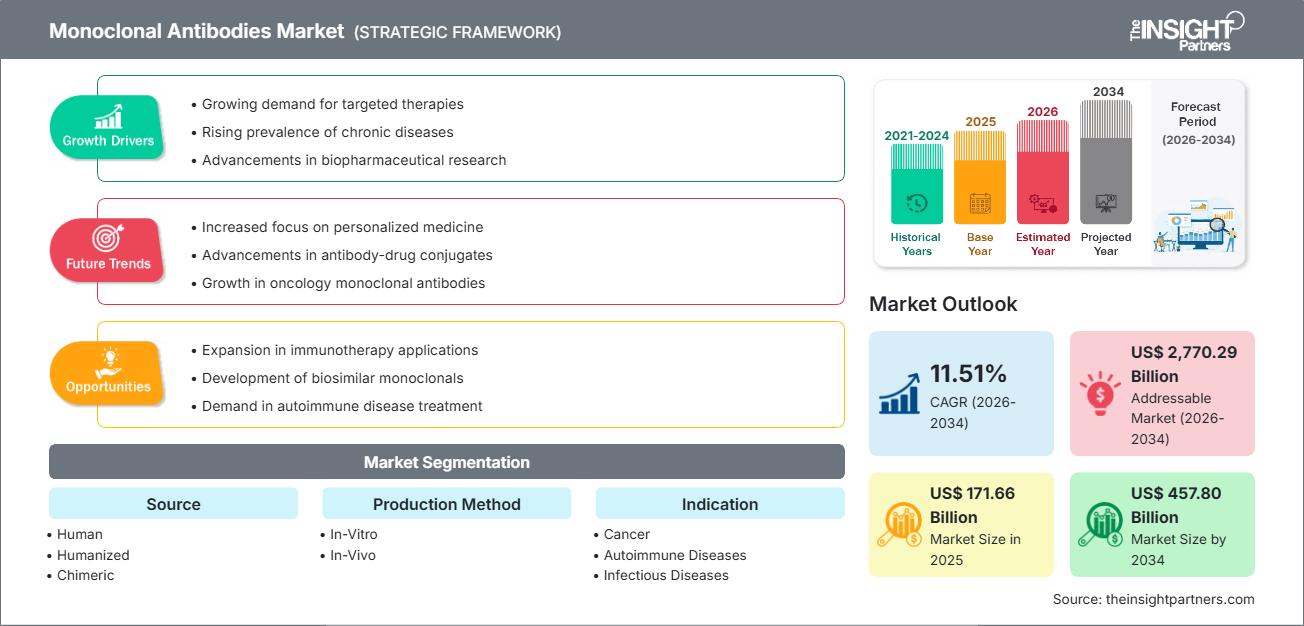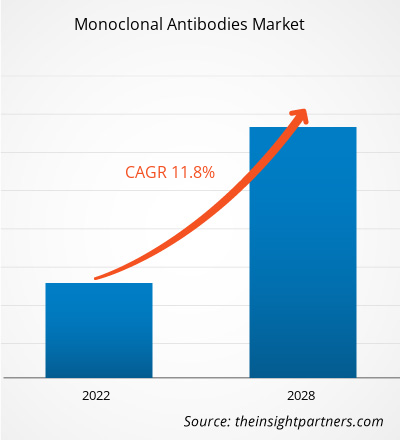单克隆抗体市场规模预计将从2025年的1716.6亿美元增长到2034年的4578亿美元。预计该市场在2026年至2034年期间的复合年增长率将达到11.51%。
单克隆抗体市场分析
受慢性病患病率上升、生物技术进步以及对靶向治疗需求不断增长的推动,单克隆抗体市场正在快速扩张。杂交瘤技术、噬菌体展示技术和重组DNA技术等技术正日益广泛地应用于肿瘤、自身免疫性疾病和传染病领域的药物发现、诊断和治疗。制药和生物技术公司正越来越多地利用单克隆抗体来改善治疗效果、减少副作用并开发新的治疗方法。随着个性化医疗的兴起、生物类似药的开发以及单克隆抗体在新发传染病治疗中应用的不断广泛,预计单克隆抗体市场将持续快速增长。
单克隆抗体市场概览
单克隆抗体在医疗保健领域的应用有助于提高治疗的疗效和特异性。单克隆抗体能够靶向特定的疾病标志物,预测患者的治疗反应,提供诊断工具,检测疾病发展趋势等等。目前,各大制药公司都参与了单克隆抗体的研发。单克隆抗体疗法用于分析疾病机制,并靶向特定抗原,从而为患者提供个性化治疗。靶向治疗的概念在此得到广泛应用。企业需要通过有效的治疗来维持患者的治疗意愿,并加大研发投入。
根据您的需求定制此报告
您可以免费获得任何报告的定制服务,包括本报告的部分内容、国家/地区层面的分析、Excel 数据包,以及面向初创企业和高校的优惠折扣。
单克隆抗体市场:战略洞察

-
获取本报告的主要市场趋势。这份免费样品将包含数据分析,内容涵盖市场趋势、估算和预测等。
单克隆抗体市场驱动因素和机遇
市场驱动因素:
- 慢性疾病日益普遍:全球癌症、自身免疫性疾病和炎症性疾病的发病率不断上升,推动了对单克隆抗体等有效靶向治疗方案的需求。
- 蛋白质工程和生物技术的进步:抗体工程、人源化技术和表达系统的不断创新,正在推动开发出更有效、更安全、具有改进药代动力学的新型 mAb 构建体。
- 研发投入不断增加:制药公司和政府机构对新型治疗性抗体的研发投入巨大,正在加速药物发现和市场增长。
- 真实世界的临床成功与患者需求:单克隆抗体在治疗各种疾病方面已证实有效且安全性得到改善,这导致了广泛的临床应用和较高的患者需求,进一步推动了市场扩张。
市场机遇:
- 生物类似药开发:几款重磅单克隆抗体的专利到期,为生物类似药生产商提供了一个绝佳的机会,让他们能够以更实惠的替代品进入市场,从而增加患者的用药机会和市场份额。
- 新兴治疗领域:拓展到新的治疗领域,如神经系统疾病、罕见病和传染病(例如 COVID-19 抗体),为 mAb 开发提供了巨大的增长潜力。
- 个性化医疗方法:将单克隆抗体与伴随诊断和生物标志物驱动策略相结合,可以实现高度个性化的治疗,改善患者预后并扩大市场领域。
单克隆抗体市场报告细分分析
单克隆抗体市场份额按不同细分市场进行分析,以便更清晰地了解其结构、增长潜力和新兴趋势。以下是大多数行业报告中使用的标准细分方法:
来源:
- 人类
- 人性化
- 嵌合体
- 小鼠
按生产方法:
- 体外
- 体内
按指示:
- 癌症
- 自身免疫性疾病
- 传染病
- 炎症性疾病
- 微生物疾病
按申请方式:
- 治疗应用
- 诊断应用
- 研究应用
按地理位置:
- 北美
- 欧洲
- 亚太
- 南美洲和中美洲
- 中东和非洲
单克隆抗体市场区域洞察
The Insight Partners 的分析师对预测期内单克隆抗体市场的区域趋势和影响因素进行了详尽的阐述。本节还探讨了北美、欧洲、亚太、中东和非洲以及南美和中美洲等地区的单克隆抗体市场细分和地域分布。
单克隆抗体市场报告范围
| 报告属性 | 细节 |
|---|---|
| 2025年市场规模 | 1716.6亿美元 |
| 到2034年市场规模 | 4578亿美元 |
| 全球复合年增长率(2026-2034 年) | 11.51% |
| 史料 | 2021-2024 |
| 预测期 | 2026-2034 |
| 涵盖部分 |
按来源
|
| 覆盖地区和国家 |
北美
|
| 市场领导者和主要公司简介 |
|
单克隆抗体市场参与者密度:了解其对业务动态的影响
单克隆抗体市场正快速增长,这主要得益于终端用户需求的不断增长,而终端用户需求的增长又源于消费者偏好的转变、技术的进步以及消费者对产品益处的认知度不断提高。随着需求的增长,企业不断拓展产品和服务,持续创新以满足消费者需求,并把握新兴趋势,这些都进一步推动了市场增长。

- 获取单克隆抗体市场主要参与者概览
单克隆抗体市场份额地域分析
北美在单克隆抗体市场占据主导地位。该地区的优势地位日益巩固,这得益于其完善的医疗基础设施、高额的研发投入以及众多大型制药公司的存在。此外,美国政府也积极支持生物技术进步和药物研发。南美和中美洲、中东以及非洲等新兴市场也为单克隆抗体供应商提供了许多尚未开发的拓展机遇。
由于医疗保健体系的先进程度、监管框架、疾病流行情况以及生物制药研发投入等因素的影响,单克隆抗体市场在不同地区的增长轨迹各不相同。以下是各地区市场份额和趋势概述:
1. 北美洲
- 市场份额:凭借强大的研发基础设施、先进疗法的广泛应用以及大量的医疗保健支出,占据最高的市场份额。
-
关键驱动因素:
- 癌症和自身免疫性疾病等慢性疾病高发。
- 众多领先的生物制药公司和研究机构入驻。
- 有利于药物研发的监管环境。
- 趋势:关注新型药物输送系统、个性化医疗和生物类似药审批。
2. 欧洲
- 市场份额:市场份额显著,这得益于有利的报销政策和对 mAb 疗法的认识不断提高。
-
关键驱动因素:
- 人口老龄化和慢性病发病率上升。
- 政府支持医药创新的举措。
- 由于成本效益高,生物类似药的应用日益广泛。
- 趋势:强调药物有效性的真实世界证据,并扩大现有单克隆抗体的治疗适应症。
3. 亚太地区
- 市场份额:中国、印度和日本等国家医疗保健基础设施的改善、可支配收入的增加以及患者意识的提高,推动了该地区市场的增长,使其成为增长最快的区域市场。
-
关键驱动因素:
- 患者群体庞大,慢性病患病率不断上升。
- 对医疗保健和生物制药研发的投资不断增长。
- 扩大国内单克隆抗体和生物类似药的生产能力。
- 趋势:生物类似药的快速普及、注重本地药物研发以及获得先进疗法的机会增加。
4. 南美洲和中美洲
- 市场份额:新兴地区,由于医疗保健服务的改善和经济增长,先进疗法的应用日益普及。
-
关键驱动因素:
- 医疗保健支出增加和医疗保健系统现代化。
- 慢性病和传染病发病率不断上升。
- 努力扩大创新疗法的可及性。
- 趋势:发展本地生产能力、扩大生物类似药市场、开展国际药物获取合作。
5. 中东和非洲
- 市场份额:新兴市场具有强劲的增长潜力,这得益于阿联酋、沙特阿拉伯和南非等国的医疗改革和对制药行业的投资不断增加。
-
关键驱动因素:
- 政府采取措施加强医疗服务和基础设施建设。
- 人们对先进治疗方案的认识和需求不断提高。
- 本地和国际制药公司之间的战略伙伴关系。
- 趋势:重点发展本地生物制药产业,提高靶向疗法的采用率,并满足未满足的医疗需求。
单克隆抗体市场参与者密度:了解其对业务动态的影响
由于全球大型制药和生物技术公司以及新兴的利基市场参与者和专业初创公司的加入,单克隆抗体市场竞争日趋激烈。各公司正积极创新,以巩固其市场地位,并满足针对各种疾病的靶向有效治疗日益增长的需求。
竞争格局促使供应商通过以下方式实现差异化:
- 各组织正在采用先进的蛋白质工程技术来开发新型单克隆抗体构建体,以提高疗效、降低免疫原性并增强安全性。
- 目前的解决方案包括将单克隆抗体与其他药物相结合的联合疗法,从而提高治疗效果并解决复杂的疾病机制。
- 由于药品审批和患者安全方面的监管要求非常严格,各组织更加注重强有力的临床试验和上市后监测,以确保合规性并建立与医疗保健提供者和患者的信任。
机遇与战略举措
- 制药公司正利用研发为以前无法治疗的疾病提供高度特异性和强效的单克隆抗体疗法,通过卓越的临床疗效和专利保护开辟新的收入来源。
- 通过战略合作、合并和收购,各公司正在构建多元化的产品线,扩大地域覆盖范围,并整合用于药物发现和开发的新技术,从而对下一代单克隆抗体疗法进行有意义的投资。
- 大型企业要么收购小型生物技术初创公司,要么与这些初创公司合作,以引入创新平台和在双特异性抗体、抗体药物偶联物 (ADC) 和基因编辑技术等领域的专业知识。
单克隆抗体市场的主要企业包括:
- 诺华公司
- 辉瑞公司
- 葛兰素史克公司
- 安进公司
- 第一三共株式会社
- 罗氏制药
- 阿斯利康
- 礼来公司
- 拜耳股份公司
免责声明:以上列出的公司不分先后顺序。
单克隆抗体市场新闻及最新进展
- 例如,2025 年 11 月 19 日,诺华公司在美国风湿病学会大会上发表了关于 ianalumab 在干燥症(第二大常见风湿性自身免疫性疾病)中的最新数据。
- 2025年9月9日,诺华宣布已达成协议收购总部位于纽约的上市临床阶段生物制药公司Tourmaline Bio, Inc.。该公司专注于开发抗IL-6单克隆抗体pacibekitug,作为治疗动脉粥样硬化性心血管疾病的方案。Pacibekitug靶向IL-6(一种促进全身炎症的关键上游细胞因子),从而满足了诺华的心血管策略,并填补了尚未满足的重大医疗需求。目前,Pacibekitug的II期临床试验已进展顺利,此次收购将使诺华获得一项已进入III期临床试验阶段的资产,进一步完善其现有的心血管疾病产品组合。
- 2025 年 9 月 7 日,Ifinatamab deruxtecan 是一种专门设计的、潜在的首创的 B7-H3 靶向 DXd 抗体药物偶联物 (ADC),由第一三共株式会社发现,并由第一三共株式会社和默克公司(位于美国新泽西州拉威市,在美国和加拿大以外地区称为 MSD)联合开发。
单克隆抗体市场报告涵盖范围及成果
《单克隆抗体市场规模及预测(2021-2034)》报告对市场进行了详细分析,涵盖以下领域:
- 单克隆抗体市场规模及预测,涵盖全球、区域和国家层面的所有关键市场细分领域。
- 单克隆抗体市场趋势,以及市场动态,例如驱动因素、制约因素和主要机遇。
- 详细的PEST和SWOT分析
- 单克隆抗体市场分析,涵盖关键市场趋势、全球和区域框架、主要参与者、法规以及近期市场发展动态。
- 单克隆抗体市场行业格局及竞争分析,涵盖市场集中度、热力图分析、主要参与者及最新发展动态。提供详细的公司简介。
- 历史分析(2 年)、基准年、预测(7 年)及复合年增长率
- PEST和SWOT分析
- 市场规模、价值/数量 - 全球、区域、国家
- 行业和竞争格局
- Excel 数据集
近期报告
客户评价
购买理由
- 明智的决策
- 了解市场动态
- 竞争分析
- 客户洞察
- 市场预测
- 风险规避
- 战略规划
- 投资论证
- 识别新兴市场
- 优化营销策略
- 提升运营效率
- 顺应监管趋势






















 获取免费样品 - 单克隆抗体市场
获取免费样品 - 单克隆抗体市场